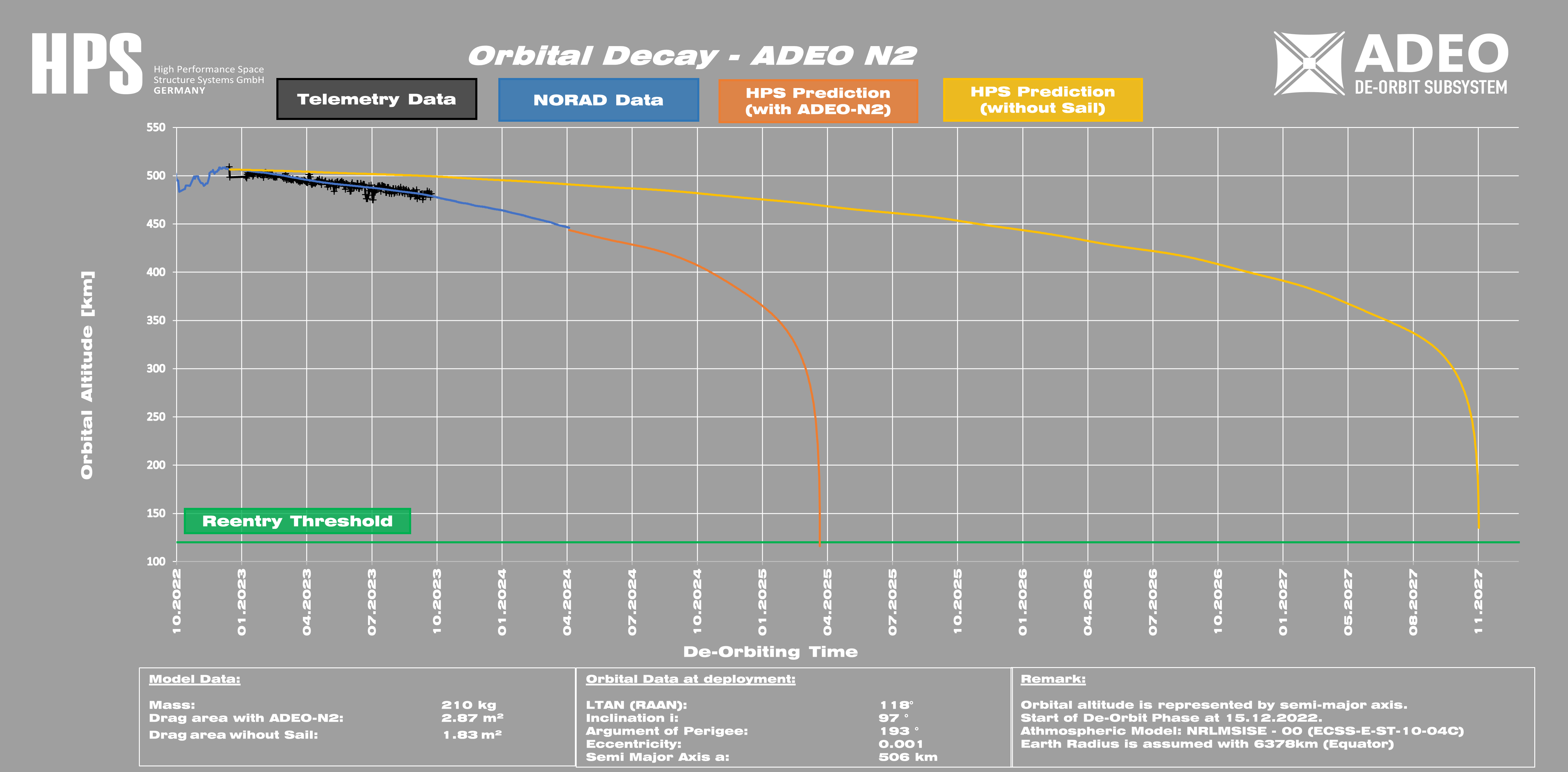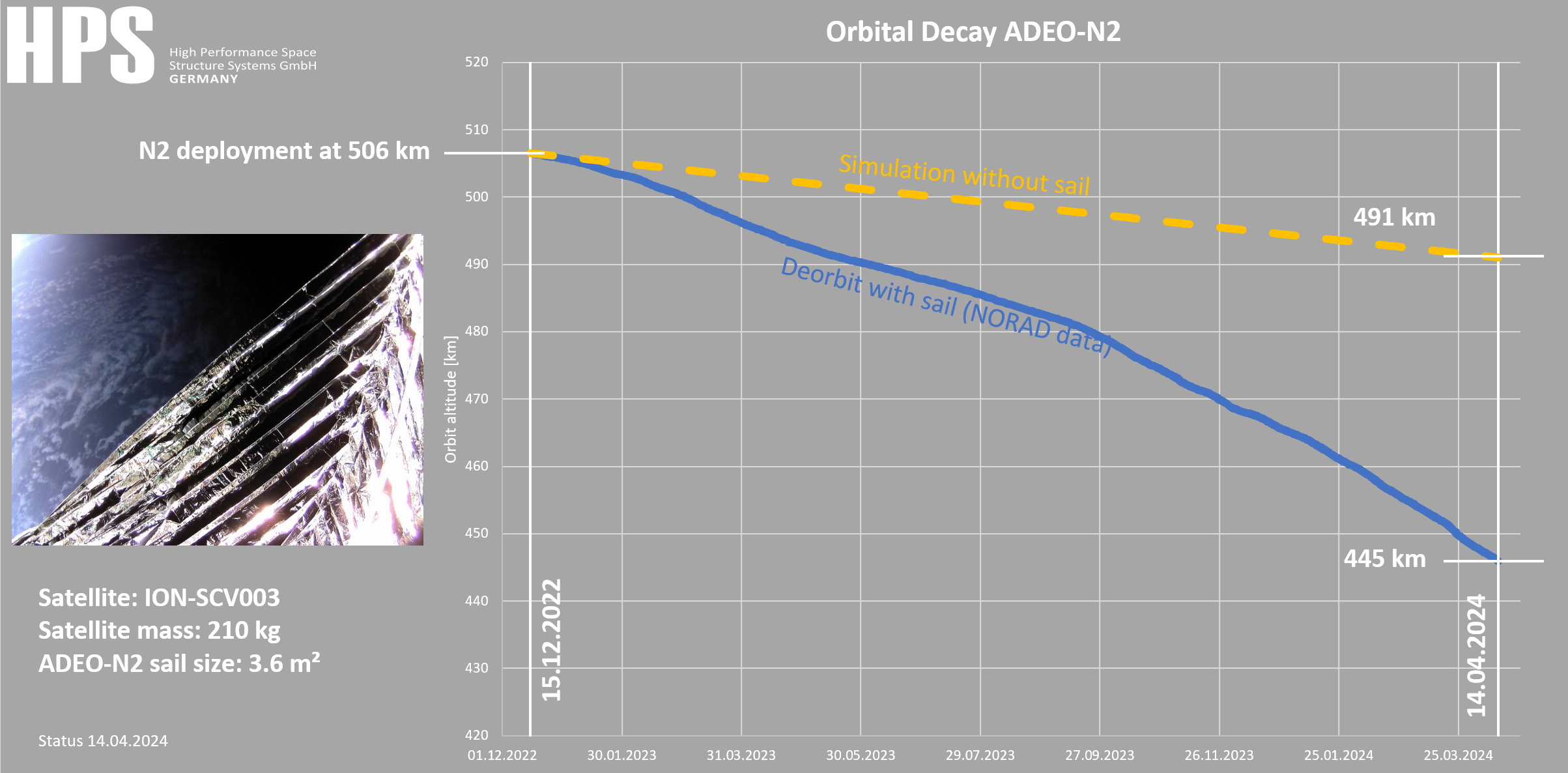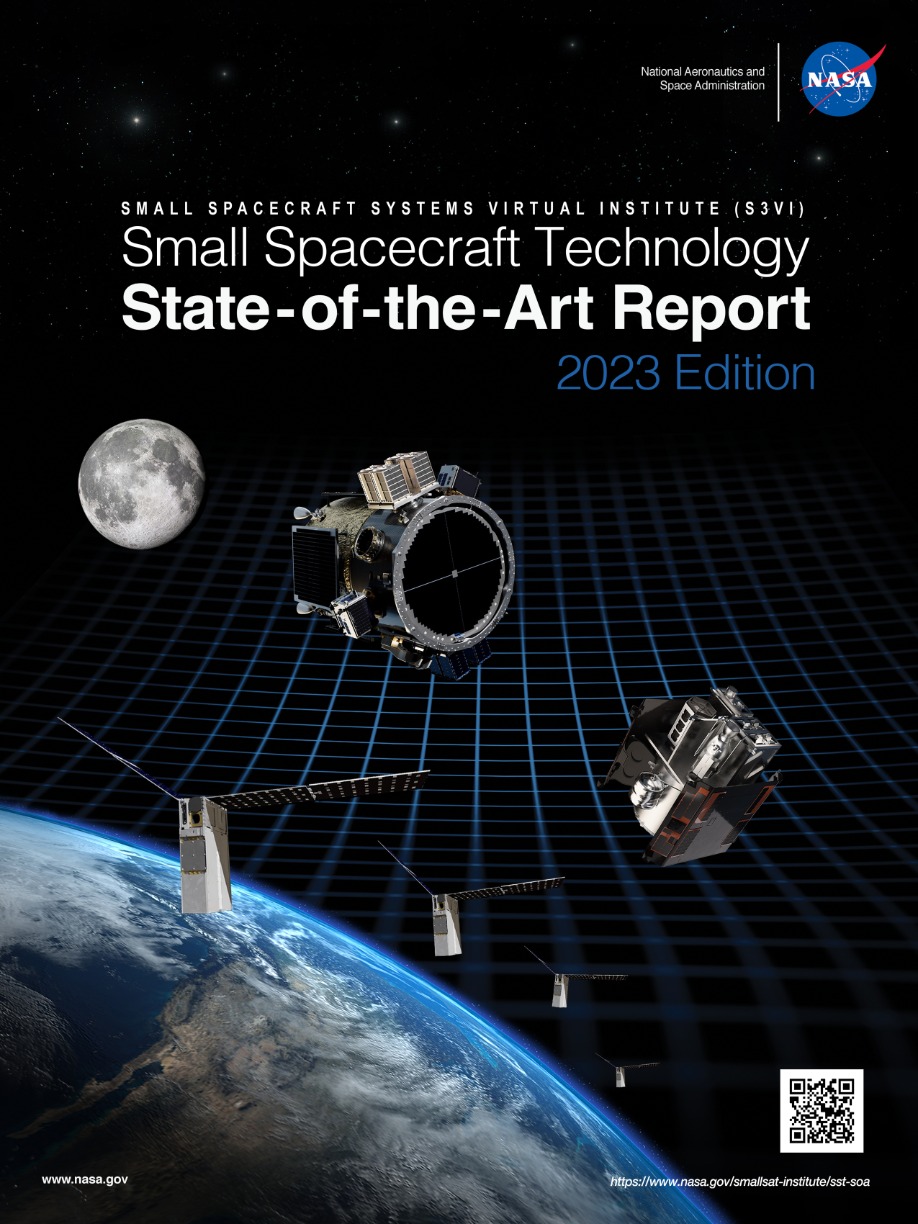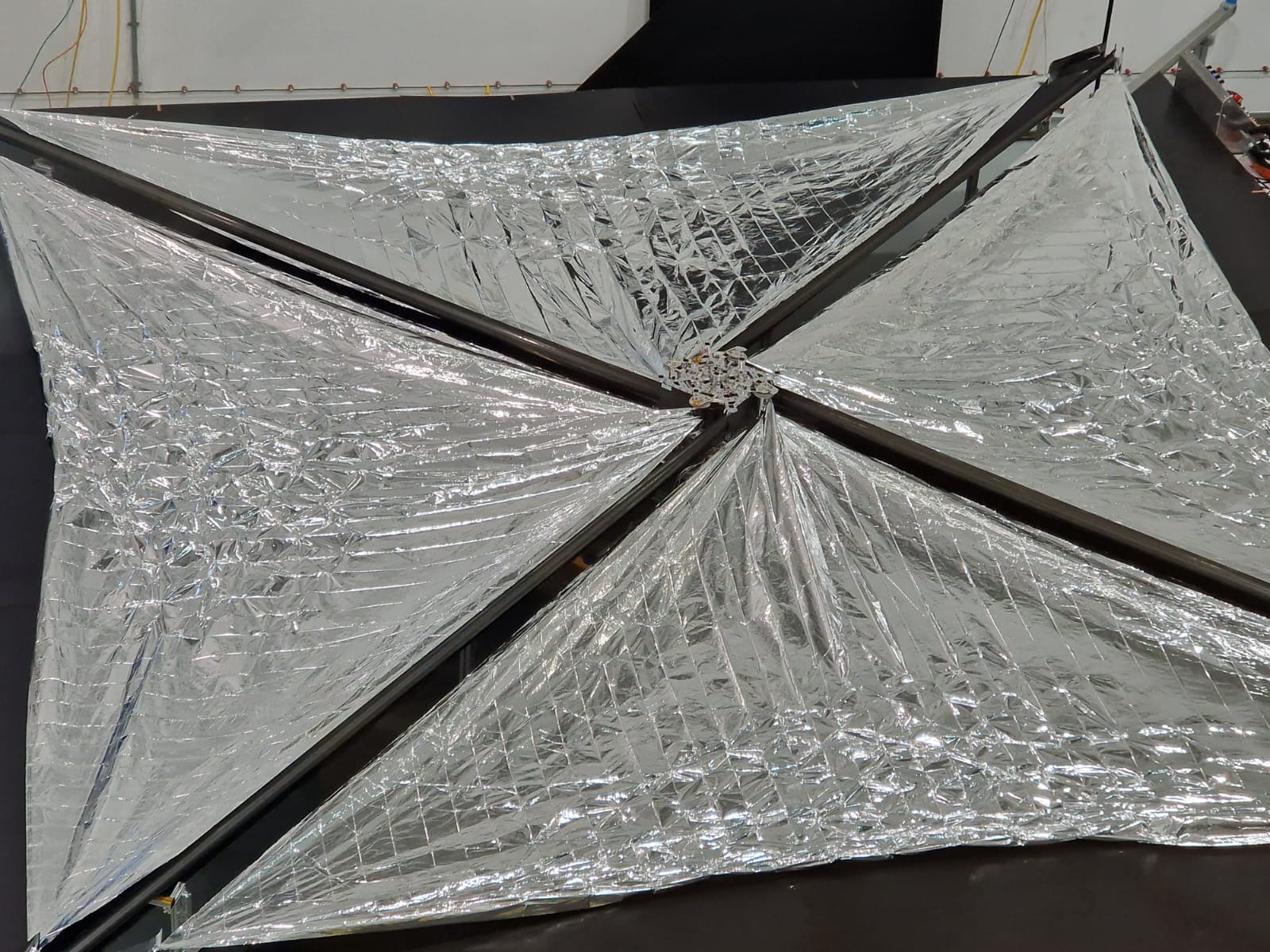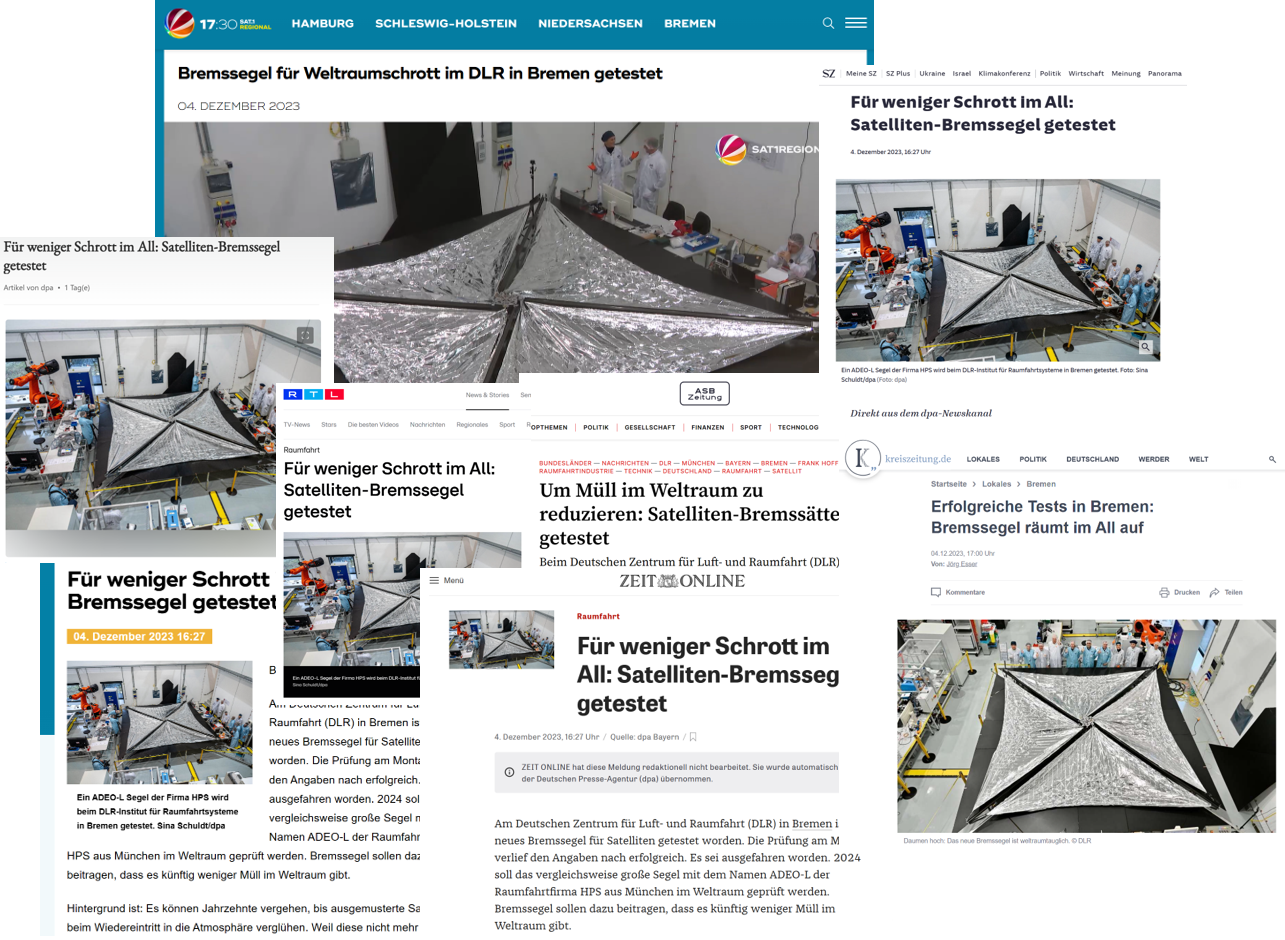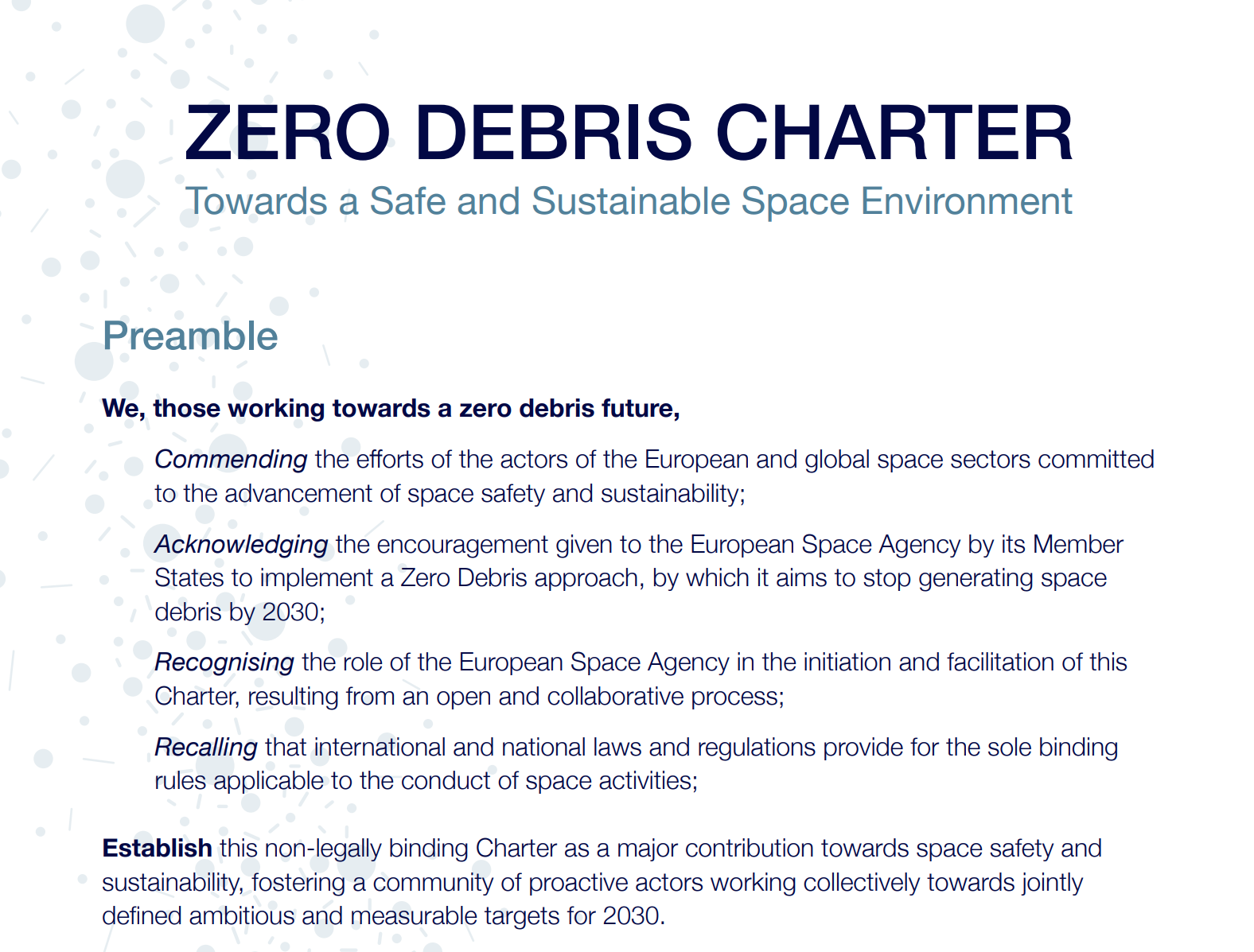September 2024
ADEO Pico: Das kleinste Bremssegel für´s All fasst Fuß auf dem größten Markt
Deorbit-Technologie von HPS
Nachdem die Tinte unter dem Vertrag für ein Satelliten-Deorbitsegel der PICO-Klasse aus der ADEO-Dragsail-Familie von HPS getrocknet ist, betritt das Münchner Raumfahrtunternehmen nun auch nordamerikanischen Boden: Das kanadische Unternehmen StarSpec Technologies entschied sich nach sorgfältiger Abwägung der Alternativen für das System zur Integration auf seinem Satelliten InspireSAT 12U ADCS MVP, der 2026 gestartet werden soll.
Der ADEO-P wurde Anfang Juli gekauft. Die Integration wird von den Experten im Jahr 2025 durchgeführt. Der Satellit soll 2026 an Bord einer Falcon9 im Rahmen der Transporter-17-Kleinsatellitenmission Rideshire vom Weltraumbahnhof Vandenburg in den USA gestartet werden. Am Ende der Mission wird das Bremssegel auf eine Größe von 1,4 m2 ausgefahren und der Satellit innerhalb der nun obligatorischen Frist von weniger als fünf Jahren automatisch entsorgt. Der Satellit wird in der Atmosphäre verglühen, ohne dabei irgendwelche Rückstände zu hinterlassen.
Diese Initiative fördert die hochpräzisen, weltraumtauglichen ADCS-Komponenten von StarSpec, darunter Sternkameras mit einer Präzision von weniger als einer Bogensekunde, zahnradlose Reaktionsräder und Steuerungen mit ultrahoher Bandbreite, die eine 100-fache Präzision und Abbildungsqualität für LEO-Abbildungssatelliten bieten.
Jason Brown, Mechanical & Technology Lead, kommentierte die Schlüsselfaktoren, die zur Auswahl des ADEO-P für InspireSAT führten: „Eine der Hauptaufgaben von InspireSAT ist es, Hochleistungsfähigkeiten in der Umlaufbahn bereitzustellen, die den kontinuierlichen und zukünftigen Nutzen von LEO nicht gefährden und aufrechterhalten. Wir freuen uns, mit HPS einen ausgewiesenen Hightech-Spezialisten der internationalen Raumfahrtindustrie an unserer Seite zu haben, der es StarSpec Technologies ermöglicht, seinen nachhaltigen und umweltbewussten Ansatz im Weltraum beizubehalten, ohne dabei den Fokus auf die erfolgreiche Demonstration unseres transformativen, hochmodernen ADCS zu verlieren. Danke HPS!“
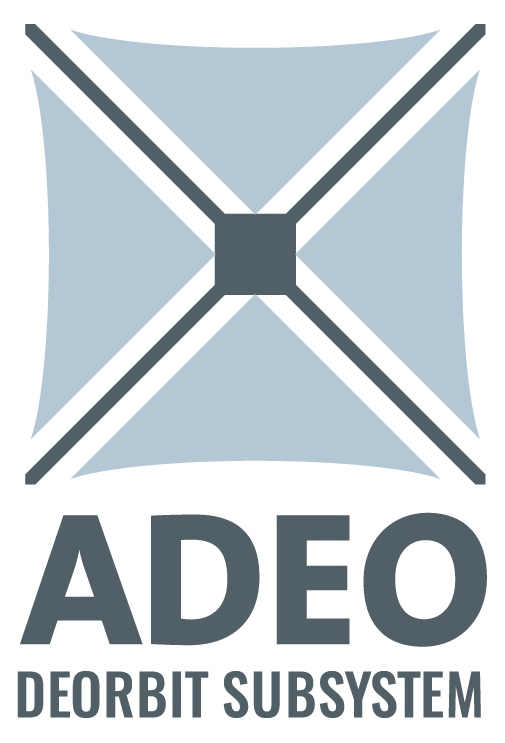
August 2024
HPS CEO: „Wünsche meinem Namensvetter eine glückliche Heimkehr“
In der Regel stehen Sinn und Zweck eines Satelliten, sei es wissenschaftlich oder geschäftlich, im Zentrum des Interesses. Es gibt aber auch wenige Ausnahmen, die diese Regel bestätigen. Eine davon ist der jüngst gestartete Flug einer unscheinbaren 18-Kilo-Kiste mit einer Falcon 9 von SpaceX auf einen niedrigen Zielorbit in 510 Kilometern Höhe. Der Name: ERNST – Abkürzung für „Experimentelle Raumfahrtanwendung von Nano-Satellitentechnologie“. Seine Mission: Mit Infrarotdetektoren aus dem All beim Überflug der Erde anhand der heißen Abstrahlung von Verbrennungsgasen erkennen, wo auf der Welt gerade zivile oder auch militärische Raketen gestartet werden – und welches Ziel sie vermutlich im Visier haben. Derartige Technik ist in den USA schon länger Standard bei den technischen Instrumenten für die nach Armee, Luftwaffe und Marine vierte Waffengattung der Nation, die „Space Forces“; in Europa steckt die entsprechende Forschung vergleichsweise noch in den Kinderschuhen, weswegen die ERNST-Mission ein wichtiger Meilenstein für Deutschland darstellt.
Dieser anwendungsbezogene Forschungszweck von ERNST befindet sich im hoch experimentellen Frühstadium, jedoch verlässt sich das renommierte Fraunhofer Institut in Freiburg hinsichtlich Weltraumschrottvermeidung wohl auf erprobte Prinzipen: Mit an Bord ist eine Bremsanlage mit entfaltbarem Segel zur beschleunigten Rückkehr nach dem Ende der etwa dreijährigen Mission. Dabei handelt es sich um eine vom Fraunhofer Institut maßgeschneiderte Version für den Minisatelliten ERNST. HPS hat hierbei hinsichtlich Segel vor knapp zehn Jahren mit Fraunhofer gemeinsam im Rahmen einer Masterarbeit zusammengearbeitet und unterstützt. HPS ist mittlerweile Vorreiter der Technologie und derzeit weltweit einziger kommerzieller Anbieter von flugerprobten automatischen Bremssegeln der sogenannten ADEO-Familie, mit insgesamt 5 verschiedenen Produkt-Versionen für alle Größenklassen von LEO-Satelliten. ADEO-Bremssegel entwickeln sich gerade zur Standardausrüstung, denn spätestens ab Herbst 2024 wird kein Satellit mehr vom faktischen Monopolanbieter SpaceX mehr ohne solche Bordtechnik zur beschleunigten Rückkehr im Rahmen der neuen FCC-Regularien nach Missionsende ins All transportiert.
„Nach einer gewissen Gewöhnungsphase an die neue Gesetzeslage ist der Run auf ADEO-Bremssegel mittlerweile in vollem Gange. Auch in Nordamerika haben die Kunden großes Vertrauen zu ADEO und HPS aufgebaut; hilfreich ist da sicher auch der Umstand, dass HPS mit ADEO im NASA-Technologiereport über Deorbit-Technologien den einsamen Spitzenplatz belegt. Insofern freuen wir uns natürlich extrem, parallelzu unserem kommerziellen System am Markt, nun auch durch die Zusammenarbeit mit einem der weltweit berühmtesten deutschen Forschungsinstitute weitere Punkte für Produktvertrauen und Sympathie zu sichern. Deshalb sehe ich ausnahmsweise einmal hier nicht die operative Forschungsmission, sondern deren Ende als Höhepunkt und wünsche meinem Namensvetter schon jetzt eine glückliche Heimreise“, kommentiert Ernst K. Pfeiffer, CEO von HPS.
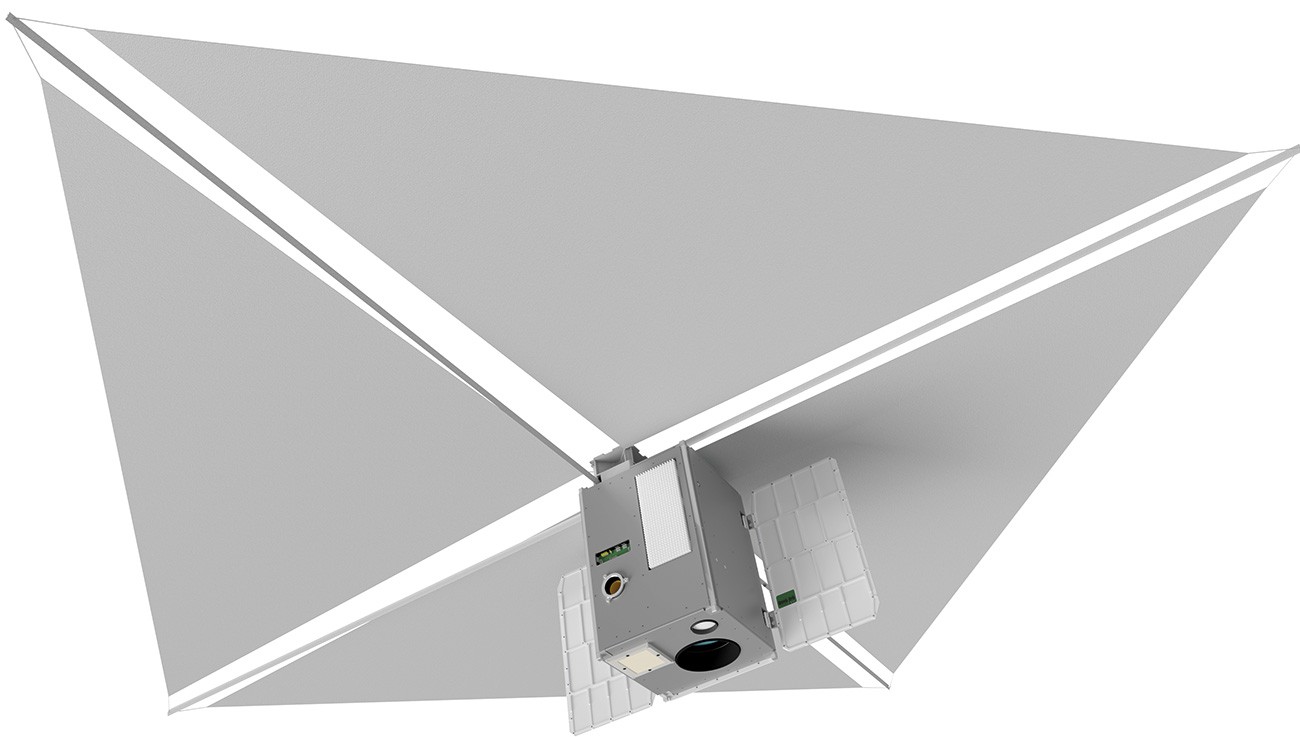
© Fraunhofer EMI

© Fraunhofer EMI
August 2024
ESA: 1 Million für Produktinnovation von HPS, AAC und DLR
Das sogenannte GSTP-Programm der ESA ist eines der wichtigsten Instrumente der europäischen Raumfahrtagentur zur Förderung neuer Techniken, welche insbesondere durch KMU generiert werden. Das Programm genießt auch bei der deutschen Raumfahrtagentur hohe Priorität im ESA-Gesamtportfolio; die entsprechende finanzielle Ausstattung ermöglicht jetzt auch die Auflage eines neuen Unterprogramms mit der Bezeichnung „Produktinitiative“. Mit Vertragsunterschrift am 7. August 2024 gaben die ESA und HPS als Hauptauftragnehmer den Startschuss für das erste Technologieprojekt aus dieser Kategorie.
Von der Idee bis zur Vertragsbesiegelung vergingen nur gut sechs Monate; die Förderungssumme beträgt eine Million Euro. Hinzu kommen 20 Prozent Eigenmittel, welche industrieseitig die Münchner Raumfahrtschmiede HPS und deren langjähriger Partner, die Wiener Neustadt Aerospace & Advanced Composites GmbH, aufbringen. Forschungsseitig ist das Bremer DLR-Institut für Raumfahrtsysteme ebenfalls an Bord. Innerhalb der kommenden 24 Monate werden in diesem Rahmen höchst innovative Folien (Arbeitsname „ProFilm“) in verschiedensten Dicken und Oberflächenkonfigurationen und für großflächige Anwendungen entwickelt, die sich vor allem durch zwei besondere Merkmale auszeichnen:
- sie sind beständig gegen die chemisch aggressiven Restsauerstoffmoleküle (ATOX-resistent) und dadurch perfekt geeignet für den Einsatz insbesondere im hoch frequentierten Bereich des Niedrigen Erdorbits LEO,
- besondere Derivate sind unsichtbar oder nicht-reflektiv.
Damit ergeben sich neben dem Einsatz als thermale Isolierung von Satelliten auch innovative Anwendungen als unsichtbare Bremssegel als Weiterentwicklung der HPS ADEO Produktreihe zum deorbitieren ausgedienter Satelliten.
Auf diese Weise dienen sie vier strategischen Zielen der europäischen Raumfahrt:
- Sicherung technologischer Unabhängigkeit von anderen großen Raumfahrtnationen, die auf diesem Gebiet schon Fortschritte gemacht haben
- Unterstützung für europäische Hersteller von Raumfahrzeugen und Satelliten, für die maximaler physischer Schutz ein Element der Wettbewerbsfähigkeit ihrer Produkte darstellt
- Vermeidung von astronomie-feindlicher Lichtverschmutzung im All durch nicht-reflektierende Oberflächen bei Dragsails sowie bei thermalen Isolationen wie MLIs, SLIs. Auch eine Verwendung für Solarpanele und Radiatoren ist vorgesehen.
Die Ideen gehen bis hin zu entfaltbaren Strukturen, die mit ProFilm ganze Satelliten unsichtbar machen könnten.
HPS-CEO Ernst K. Pfeiffer ist begeistert über den Projektstart: „Die nun angeschobenen Innovationsprozesse werden hoch spannende Produkte hervorbringen – dafür ist allein schon die Kooperation mit unseren Partnern, dem DLR im Norden wie der AAC GmbH im Süden ein Garant. Vor allem aber zeigt diese Premiere des neuen GSTP-Unterprogramms der ESA, wie schnell und effektiv die europäische Raumfahrtagentur technische Herausforderungen erkennen, annehmen und meistern kann. Genau das braucht die europäische Raumfahrt, und genau das brauchen insbesondere die Innovationstreiber aus den Reihen der KMU.“
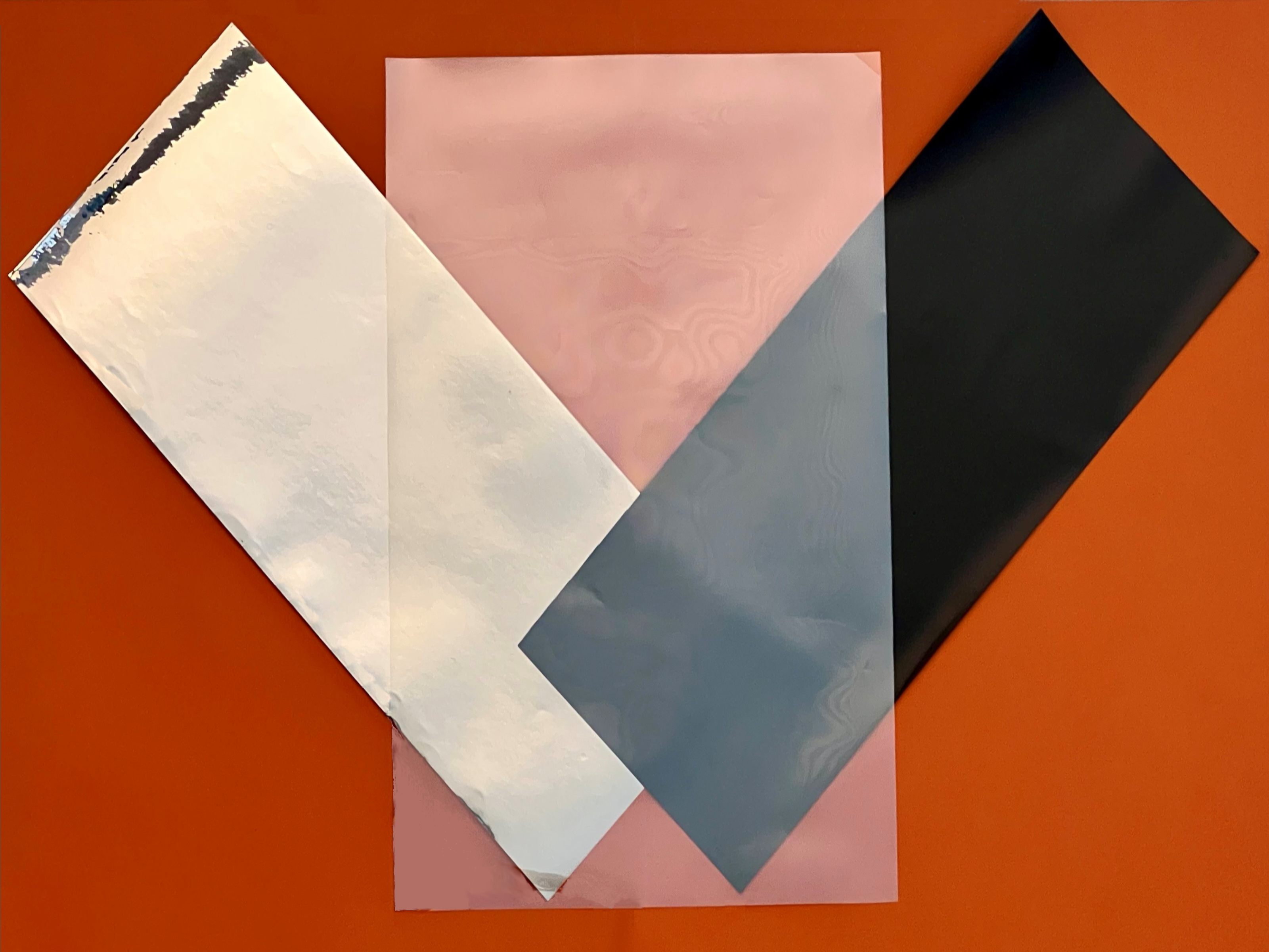
ESA treibt marktgerechte Serienfertigung mit Kofinanzierung von 1,2 Millionen Euro
Juli 2024
Deorbit-Segelsystem ADEO von HPS
Raumfahrt soll sauber und nachhaltig werden, nur dann bleibt sie auch nachfolgenden Generationen überhaupt möglich: Dieser raumfahrtpolitischen Top-Priorität verpflichtet sind mittlerweile einige technische Lösungen auf dem Markt erhältlich, allen mit großem Vorsprung voran – und unter Hervorhebung selbst seitens NASA – das Deorbit-System ADEO von HPS: Das Bremssegel für ausgediente Satelliten sorgt quasi schon vor dem Start dafür, dass aus ihnen später erst gar kein Weltraummüll wird.
Die europäische Raumfahrtagentur ESA hat – wie auch ihr nationales Pendant DLR und das bayerische Wirtschaftsministerium – über viele der mittlerweile zwölf Jahre dauernden Entwicklung dieses Produktes von HPS konsequent unterstützt. Die nun stark gestiegene Nachfrage von Kunden insbesondere derzeit im CubeSat- und SmallSat-Bereich aus Europa, aber auch aus Nordamerika und selbst aus Asien wird getrieben von dem simplen Umstand, dass sowohl die ESA für europäische Starts als auch die FCC für amerikanische Raumtransporte bordeigene Systeme zum Deorbit in nunmehr nur 5 Jahren statt wie zuvor 25 Jahren vorsehen. Und auch SpaceX bestätigt: ohne dies wird kein Satellit mehr gestartet.
Mit den ADEO-Varianten „Pico“, „Cube“, „Nano“, „Medium“ und „Large“ bedient HPS den Marktbedarf über alle Größen von LEO-Satelliten auf Umlaufbahnen zwischen 300 und 900 Kilometer hinweg. Alle Varianten werden bereits gefertigt, dabei greifen die Prozesse an den Produktionsstätten von HPS in München (Deutschland) und Bukarest (Rumänien) nahtlos ineinander. Zur nichtsdestoweniger dringend erforderlichen Erhöhung des Taktes in der Serienfertigung und als Antwort auf den zunehmenden Preisdruck der New Space Szene haben HPS und die technischen ADEO-Experten der ESA eine Reihe von Optimierungs- und Erweiterungspotentialen identifiziert. Den zur Umsetzung kurzfristig notwendigen Mittelaufwand stemmt das Unternehmen jetzt unter Verwendung einer von der ESA am 28. Juni 2024 unterzeichneten Kofinanzierung in Höhe von 1,2 Millionen Euro.
ESA-Direktor Dietmar Pilz für Technologie, Engineering und Qualität in einer Videokonferenz am 02. Juli: „my best wishes for this important technology development.“
HPS-CEO Ernst K. Pfeiffer: „Wir freuen uns als Unternehmen sehr über das Vertrauen und die kontinuierliche Unterstützung durch die europäische Raumfahrtagentur, und indirekt somit auch durch das deutsche Wirtschaftsministerium. Mindestens genauso ist dies jedoch Grund zur Freude für alle, die Europa dank seiner Technologieprogramme wie GSTP in einer führenden Rolle bei der Entwicklung von Komponenten von Raumfahrttechnik und -transport gerade in den kommerziell so wichtigen LEO- und auch MEO- Zulieferungsmarkt sehen möchten.
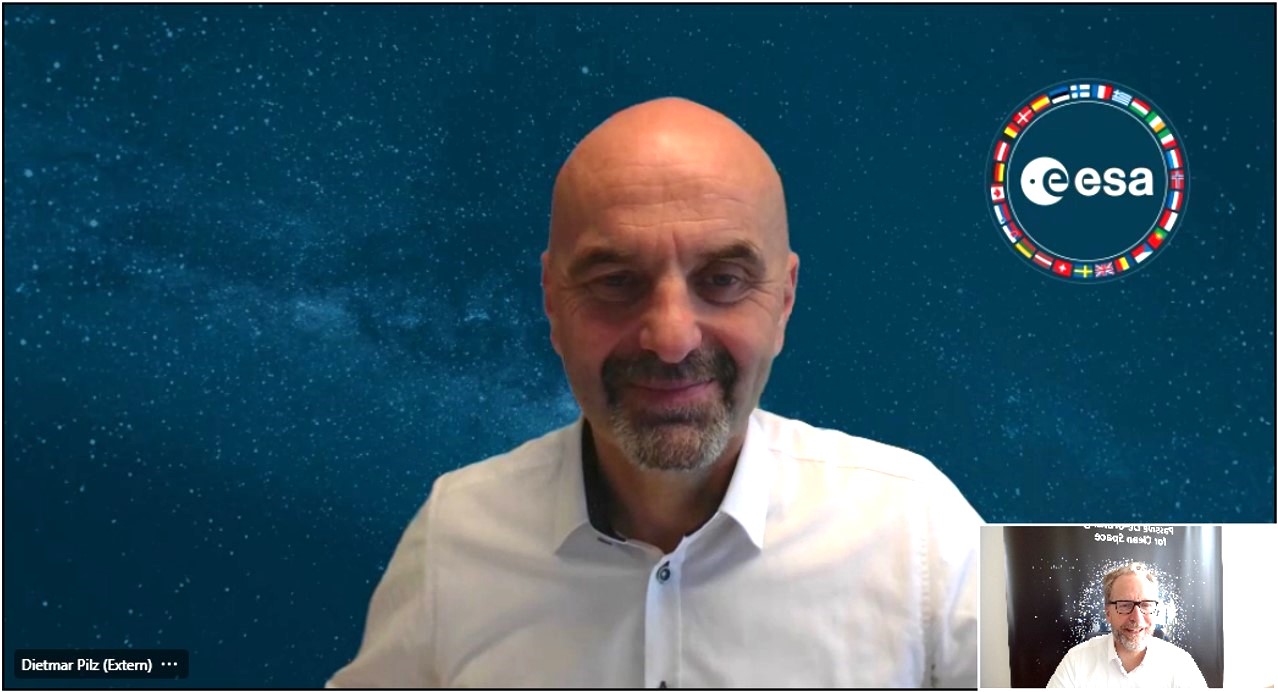
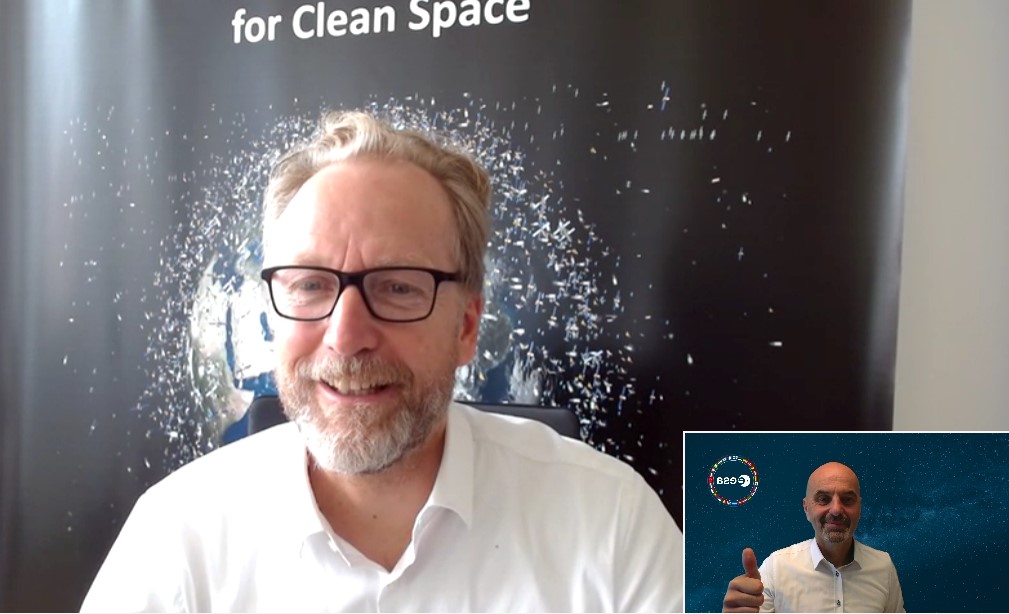
Die Prioritäten der ESA sind hier nicht nur klar, sondern werden auch konsequent umgesetzt. Ein Meilenstein war ja kürzlich die Unterzeichnung der Zero Debris Charter in Berlin. Die anstehenden Optimierungen der Serienproduktion und die Erweiterung des Portfolios unserer ADEO-Produktfamilie, bei gleichbleibender Qualität und Zuverlässigkeit, werden effektiv helfen, die Spitzen auch sehr spät eingegangener weltweiter Bestellungen abzufedern und so dennoch den Start dieser Satelliten zu ermöglichen. Unsere Eigenmittel – über die Jahre im 7-stelligen Bereich – sehen wir Gesellschafter einerseits als Investition in eine starke Zukunft von HPS und andererseits als unsere moralische Verpflichtung, einen Beitrag zu leisten für die nachhaltige Nutzung des Weltraums“.
HPS-Unterzeichnung der Zero Debris Charta auf der ILA am 6. Juni 2024
Juni 2024
ESA setzt Zeichen: Schnelle Umsetzung der Zero Debris Charta
Nachhaltigkeit in der Raumfahrt ist ein Thema schon seit Jahren auch für die europäische Raumfahrtagentur ESA. Doch vom Beschluss einer Zero Debris Charta bis zur Umsetzung vergingen letztlich nur wenige Monate.
Dies sah auch Keynote-Speaker ESA-Generaldirektor Josef Aschbacher als Zeichen dafür, dass die Zeit endgültig reif ist für konkrete Schritte anstelle reiner Symbolik, zumal die ESA selbst wesentliche Anstöße für die Entwicklung der beiden Haupttechnologien auf dem Weg zu „Zero Debris“ gegeben hat: einmal Wege der Entfernung von Schrott aus dem Raum, darüber hinaus aber vor allem die Ausrüstung von Satelliten mit Deorbit-Technik von Anfang an, sodass nach Missionsende erst gar kein Müll mehr entsteht.
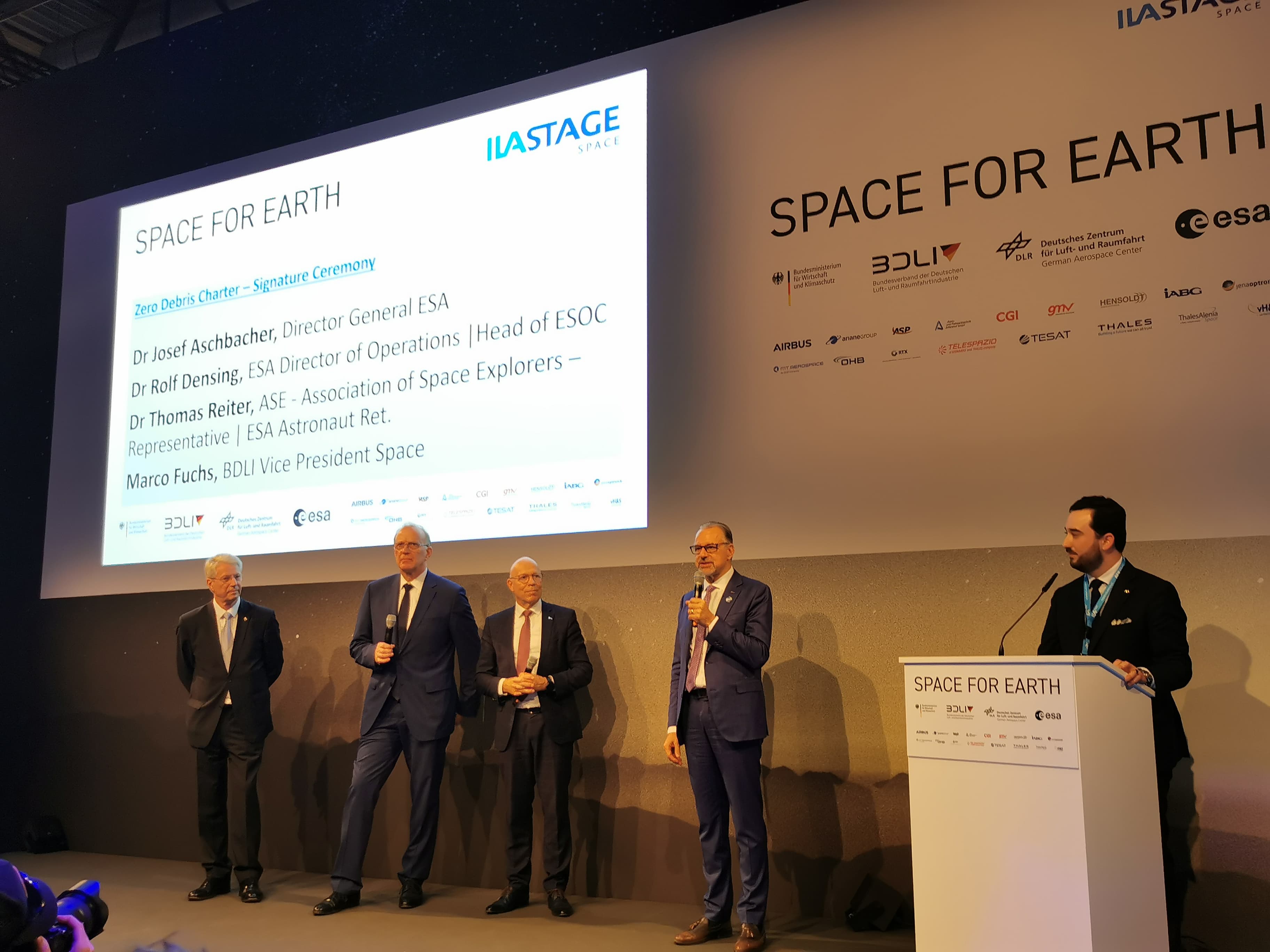
ADEO-Bremssegel: Der Schlüssel zur nachhaltigen Raumfahrt
Dafür steht das mittlerweile als ganze Produktfamilie für jede Größe von LEO-Satelliten aus Serienproduktion von HPS erhältliche Bremssegel ADEO. Rund 12 Jahre Entwicklungszeit und neben Zuwendungen und Unterstützungen von ESA, DLR und Bayern hat HPS-CEO Ernst K. Pfeiffer auch viel firmeneigenes Geld in das Projekt investiert, stets in der festen Überzeugung, dass die Stunde von ADEO früher oder später kommen würde – und wenn etwas später, dann umso mehr mit Macht.
Genauso war es dann auch, als einerseits Mitte 2023 nun auch die ESA die neue Regel ein Deorbit-Maximum bei 5 statt wie vorher 25 Jahren für ESA-finanzierte Missionen setzte, und andererseits entsprechend schon ab Oktober 2024 LEO-Satelliten ohne ADEO (o.ä.) erst gar nicht mehr gestartet werden, wie zum Beispiel SpaceX in seinen Beförderungsbedingungen gemäß FCC Regularien klar macht.
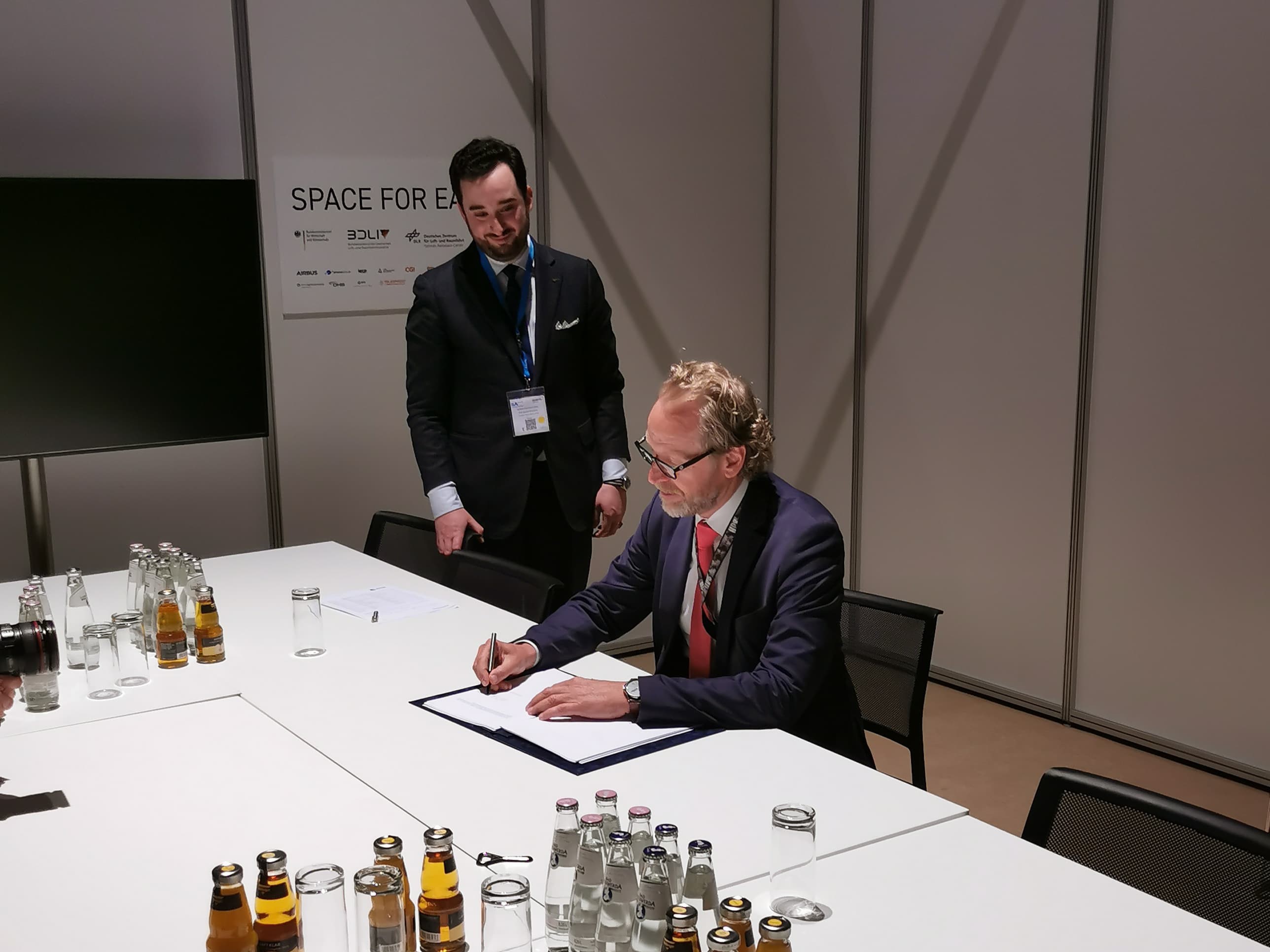
Historischer Moment: 12 Staaten unterzeichnen Zero Debris Charta
Die Charta wurde bereits am 22. Mai in Brüssel feierlich von 12 Staaten unterzeichnet, darunter auch Deutschland. Über 100 Organisationen, Firmen und Unternehmer warten seither auf ihr Stichwort zur Unterzeichnung.
Die ILA 2024 markiert auf diesem Weg hin zur Nachhaltigkeit der europäischen Raumfahrt eine ganz wesentliche Etappe und Firmen anderer Kontinenten eine Vorbildfunktion.

Mai 2024
Update on ADEO´s Performance
Nach 487 Tagen im „Lande“-Anflug Richtung Erde segelt ADEO-N2 auf dem Testsatelliten ION SCV 3 weiterhin ohne auch nur eine Schramme auf Rekordkurs: aus der derzeitigen Position ergibt sich eine dreifach kürzere Zeit des ADEO-Deorbits im Vergleich zu den klassischen Missionen, deren Daten den Prognose-Algorithmen unterliegen.
Voraussichtlicher Touchdown am Rand der Erdatmosphäre: April 2025.
Dies berichten die beiden Missionsverantwortlichen, D-Orbit, Rom (Satellit) und HPS, München (Bremssegel)
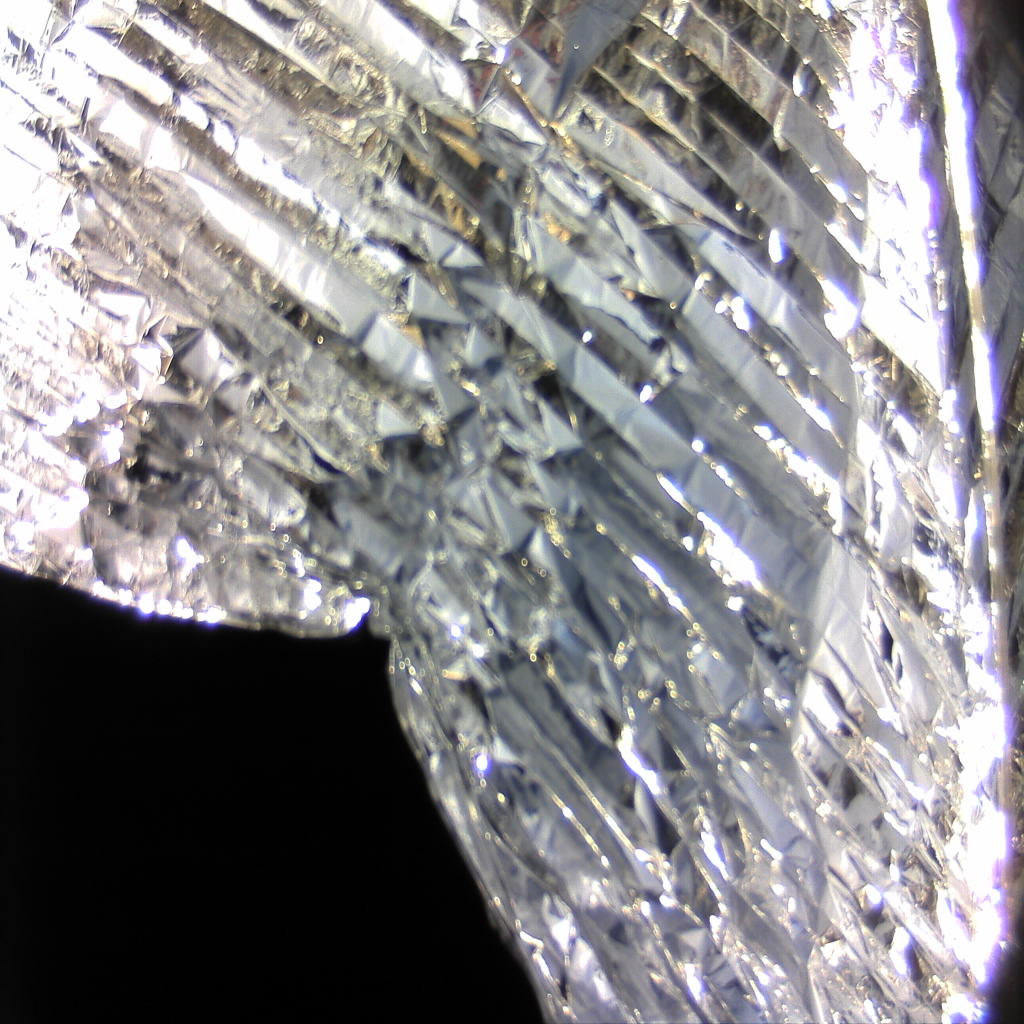
Februar 2024
ADEO auf Spitzenplatz im Technologiereport der NASA
Seit ihrer Gründung ist die amerikanische Raumfahrtagentur NASA der wichtigste Treiber des Fortschritts in Luft- und Raumfahrttechnik. Das NASA-Programm für wissenschaftliche und technische Informationen (STI) spielt eine Schlüsselrolle dabei, dass die NASA diese wichtige Rolle beibehält. Dessen Technical Reports Server enthält eine der größten Sammlungen von luft- und raumfahrtwissenschaftlichen STI der Welt, unter anderem in Form von „Technischen Veröffentlichungen“ über entscheidende Forschungen und Errungenschaften von bleibendem Wert.
Deorbit-Technologien im Fokus
Ziel des neuesten, im Februar 2024 erschienenen Werks über bahnbrechende Technologien vor allem im Bereich der Kleinsatelliten ist unter anderem die Darstellung der weltweit führenden Deorbit-Technologien, mit denen sich die in den USA wie in Europa geltende neue, von 25 auf nun 5 Jahre scharf begrenzte Vorschrift zur Entsorgung von LEO-Satelliten technisch umsetzen lassen. In ihren Bewertungskriterien für Technologien orientiert sich die NASA vornehmlich am TRL-Standard der jeweiligen Produkte, und zollt darüber hinaus auch der erreichten Skalierbarkeit große Aufmerksamkeit.
ADEO hat alles: Spitzenwerte bis TRL-9, Skalierbarkeit und Flugerfolge
In diesem Sinne nimmt laut NASA das entfaltbare Bremssegel-System ADEO aus dem Hause HPS in der Kategorie der passiven Deorbit-Systeme die führende Position auf dem Weltmarkt ein. Denn ADEO bietet nicht nur technologische Reife bis hin zum Spitzenwert von TRL-9, sondern auch eine erfolgreiche Flughistorie („flight heritage“) und ist zudem für die Ausrüstung unterschiedlicher Kleinsatellitenformate durch die HPS-Serienfertigung einer ganzen Produktfamilie vorbereitet. Diese breite Absicherung der Führungsposition von HPS mit ADEO wird von der NASA ausführlich gewürdigt – und das, obwohl sie sich selbst mit mehreren Projekten in diesem Feld als Konkurrenten ausweist:
„Das Drag Augmentation Deorbiting System (ADEO) ist ein Widerstandssegel, das von der deutschen Firma High Performance Space Structure Systems (HPS) entwickelt wurde. Das Segel ist skalierbar, und HPS hat bereits eine Reihe von Missionen mit verschiedenen Konfigurationen bis TRL 9 gestartet. Die ADEO-N-Serie ist auf kleine Satellitenmissionen von 20-250 kg zugeschnitten, während die ADEO-M- und ADEO-L-Serien für größere Missionen von 100-700 kg bzw. 500-1500 kg bestimmt sind. Die ADEO-N-Serie entspricht einer Segelgröße von 5±2 m2, während ADEO-M Flächen von 15 ± 5 m2 abdeckt. Es gibt auch kleinere Versionen, insbesondere für Picosatelliten (ADEO-P) und CubeSats (ADEO-C), und die Möglichkeit, die Segelgröße nach Kundenwunsch zu konfigurieren. Verschiedene Missionen haben die ADEO-N Produktfamilie bereits getestet. Der NABEO-1 wurde 2018 auf einer Rocket Lab Electron Rakete Kick Stage gestartet. Das Segel wurde bereits 90 Minuten nach dem Start entfaltet. Es gab ein Problem bei der Messung, ob das Widerstandssegel anfänglich entfaltet wurde, aber optische Bodenbeobachtungen bestätigten die erfolgreiche Entfaltung und Leistung. Ende Dezember 2022 wurde das ADEO-N2-Segel vom Raumfahrzeugträger ION-2 des italienischen Startdienstleisters D-Orbit ins All gebracht. Die erfolgreiche Entfaltung wurde von der Bordkamera des ION-Trägers aufgenommen.“
ADEO – Deorbit-Technologie als Voraussetzung für die Starterlaubnis
Mit dieser Darstellung in einer der wichtigsten Technologie-Dokumentationen der US-Raumfahrtbehörde NASA wird HPS mit ADEO zum weithin sichtbaren Leuchtturm auf dem weltweiten Feld der passiven Deorbit-Systeme für alle Satelliten, die die neue 5-Jahres-Deorbit-Vorschrift einhalten müssen, damit sie überhaupt zum Start durch amerikanische oder europäische Träger zugelassen werden.
ADEO L1 „ready for lift-off“: Größtes einsatzfähiges Bremssegel der Welt zur Entsorgung von Weltraummüll erfolgreich getestet
Dezember 2023
ADEO L1 „ready for lift-off“: Größtes einsatzfähiges Bremssegel der Welt zur Entsorgung von Weltraummüll erfolgreich getestet
HPS vervollständigt die ADEO-Segelflotte mit ihrer ersten größten Version unter der Bezeichnung L1. Deren 25 Quadratmeter Segelfläche entfaltete sich erfolgreich am 4.12.2023 in einem letzten Bodentest nach komplett durchgeführter PFM-Qualifikationskampagne. Diese beinhaltete Vibrationstests in allen Achsen sowie Tests unter Thermal-Vakuum, inclusive „hot and cold firing tests“ (Tests zur Verifikation der Entfalt-Auslösemechanismen unter extremen Temperaturen). Die Tests wurden unter Federführung des Entwicklungs-Hauptauftragnehmers HPS München durchgeführt, wobei die Tests selbst in den Anlagen des DLR-Instituts für Raumfahrtsysteme in Bremen stattfanden; ein Paradebeispiel einer Kooperation zwischen Industrie und Forschung & Entwicklung.
Dieser abschließende und wichtigste Entfalttest genoss großes Interesse der Medien (u.a. SAT1, RTL, NTV, DPA), die den 20-minütigen Ausfaltprozess filmten und das begeisterte Projektteam bei HPS und DLR dazu interviewte. Links zu den Artikeln und Videos finden Sie HIER.
Der erfolgreiche Test ist auch ein Erfolg des GSTP-Programmes der ESA, die die Entwicklung von ADEO-L1 signifikant förderte, finanziell und technisch. Technologieprogramme generell sind in der Raumfahrtbranche essentiell für unabhängige KMU für Produkte auf dem Weg zur Marktreife hin zu weltweitem Verkauf in Serie.
Die ADEO-Bremssegel entfalten sich nach Missionsende des Satelliten und stemmen sich gegen den Widerstand der Restatmosphäre, die noch auf Umlaufbahnen bis knapp eintausend Kilometern Höhe herrscht. Dadurch wird die Geschwindigkeit des Satelliten sofort drastisch verringert, und das gesamte Paket macht sich auf den dadurch beschleunigten Abgang Richtung Erdatmosphäre, wo es dann in der Reibungshitze von bis zu zweitausend Grad Celsius verglüht. Die gesamte Rückführung nimmt dabei noch deutlich weniger Zeit in Anspruch, als es die neuesten Richtlinien vorschreiben. Durfte der Prozess bis vor kurzem noch bis zu fünfundzwanzig Jahre dauern, muss er nun innerhalb von fünf Jahren abgeschlossen sein. Und damit sich die Betreiber auch daran halten, nehmen Startdienstleister wie SpaceX erst gar keine Satelliten mehr mit in den Weltraum, wenn sie nicht von vornherein mit entsprechender Rückführungstechnik ausgestattet sind.
Bei der Münchner Raumfahrtschmiede hatte man diese Entwicklung schon vor mehr als zehn Jahren im Blick, als sonst noch niemand so wirklich über Wege zur Vermeidung von Weltraumschrott nachdachte. Mit großartiger Unterstützung der Raumfahrtagenturen ESA und DLR, sowie der DLR-Institute inBremen und Braunschweig ), der Firmen DSI Bremen und früher HTS Coswig sowie zusätzlich eigenem Millionenaufwand schuf das hoch engagierte junge Expertenteam des Raumfahrt-Mittelständlers HPS bis heute eine ganze Produktfamilie unter dem Gattungsnamen ADEO von den kleinsten Versionen ADEO-P (Pico), ADEO-C (Cube) und ADEO-N (Nano) über ADEO-M (Medium) bis hin zum neuesten Mitglied der Gruppe, ADEO-L (large). Der Entwicklungs-Masterplan reicht dabei nicht nur noch weiter zu möglichen ADEO-Varianten mit bis zu 100 Quadratmetern Bremsfläche, sondern lässt darüber hinaus auch noch genügend Raum für Derivate mit ganz anderen Anwendungen wie beispielsweise das Monitoring von Weltraumschrott kleiner 1 cm direkt im All.
In seiner bislang größten flugbereiten Version L1 verfügt ADEO über ein Startgewicht von 10 kg bei Abmessungen im verpackten Zusatand von 43 cm x 43 cm x 25 cm; im Gegensatz zu den kleinen Varianten bedarf diese Einheit zudem einer eigenen Stromversorgung zur motorgesteuerten Entfaltung der Masten und Segel. ADEO-L passt perfekt auf Satelliten bis zu 1.500 Kilo-Klasse.
Im ersten Quartal des kommenden Jahres wird ADEO-L1 für seinen ersten Testflug Ende 2024/Anfang 2025 im Rahmen eines EU-Programmes auf einen Satelliten der belgischen Firma Redwire integriert.
Ihre Feuertaufe im All bestanden haben zuvor bereits die Versionen ADEO-N1 und ADEO-N2. Im Anflug auf das feurige Finale befindet sich derzeit ADEO-N2, entfaltet im Dezember 2022. Seither hat es seinen Satelliten schon von Orbithöhe 510 km auf 460 Kilometer in nur 12 Monaten abgesenkt ohne zur Hilfenahme jeglichen Treibstoffs oder Lageregelung. Erwartete „Ankunft“ in vollkommen verglühtem Zustand: Mitte 2025 – und damit sogar rund fünfmal schneller als ohne Segel und doppelt so schnell als vorgeschrieben.
ADEO-L1 wird diesen Weg der finalen In-Orbit-Verifikation ebenso sicher und souverän meistern, ist sich Firmenchef Dr.-Ing. Ernst K. Pfeiffer sicher. Danach geht es wie bei den anderen Versionen auch direkt in die Serienfertigung, für die das Unternehmen spezielle Produktionseinrichtungen an seinen Standorten München und Bukarest geschaffen hat.
HPS siegt mit Deorbit-Segel ADEO bei Raumfahrt-Wettbewerb der Bundesregierung
November 2023
Weltraumsegel der ADEO-Serie ermöglichen legalen Start und Entsorgung von Satelliten
Im Rahmen des Nationalen Programms für Weltraum und Innovation und auf Grundlage des Beschlusses des Haushaltsausschusses im November 2022 lobte die Deutsche Raumfahrtagentur einen Wettbewerb um zukunftsträchtige Raumfahrtinnovationen aus. Den Gewinner erwartet ein durchorganisierter und -finanzierter Demonstrationsflug mit Start bis 31.12.2025. Am Donnerstag, den 23. November 2023 kürte die Raumfahrtkoordinatorin der Bundesregierung, Dr. Anna Christmann, im Rahmen der Kleinsatellitenkonferenz 2023 die Münchner Raumfahrtschmiede HPS mit ihrer Weltraumsegel-Version ADEO-Cube zum Sieger des Wettbewerbs in der Kategorie Kleinsatellitennutzlast. Die ADEO-Produktfamilie ist als Serie mit unterschiedlichen Modelltypen (Pico, Cube, Nano, Medium, Large) angelegt, mit denen alle Satelliten von den Cubesats bis hin zu den größeren Vertretern mit 1,5 Tonnen (Klasse „M“) nach Missionsende automatisch aus der Niedrigen (LEO-) Erdumlaufbahn entfernt und entsorgt werden. Dieses sogenannte „Deorbiting“ mit dem ADEO-Bremssegel erfüllt nicht nur, sondern unterbietet sogar die dafür ab Oktober 2024 geltende Maximaldauer von 5 Jahren anstelle der zuvor seit den 60er Jahren üblichen Richtschnur von 25 Jahren. Das bedeutet ganz schlicht:
Ohne spezielle Bordtechnologie wie etwa das jeweils passende Weltraumsegel der ADEO-Serie von HPS wird schon bald kein Satellit mehr für den Start angenommen werden, wenn er sonst nicht anderweitig legal entsorgt werden kann. Da beispielsweise SpaceX als führender Startdienstleister diese Regel ab Oktober 2024 einführt, gilt sie praktisch schon für alle künftigen Satelliten einschließlich jener, die sich heute schon in Design- und Herstellungsphase befinden.
Es gibt, wie HPS-CEO Ernst K. Pfeiffer ausführt, noch eine einzige Alternative zu ADEO; die aber „ist chemisch, teuer und – im Fall eines havarierten Satelliten – funktionsunfähig“, stellt der passionierte Raumfahrtingenieur zur Marktposition des ADEO-Weltraumsegels fest: „ADEO ist derzeit die günstigste, zuverlässigste und sauberste Lösung für legales Deorbiting auf dem Weltmarkt, dazu dank Serienfertigung in den Häusern HPS Bukarest und HPS München verfügbar in allen Klassen und in höchstem Maße wettbewerbsfähig auf dem heiß umkämpften kommerziellen Markt für Satellitentechnik. Wir bei HPS, insbesondere bei unserem Entwicklungsteam, freuen uns alle sehr, dass unsere nachhaltige Technologie durch die Auszeichnung des Kleinsatelliten-Wettbewerbs von höchster Stelle gewürdigt wurde.“
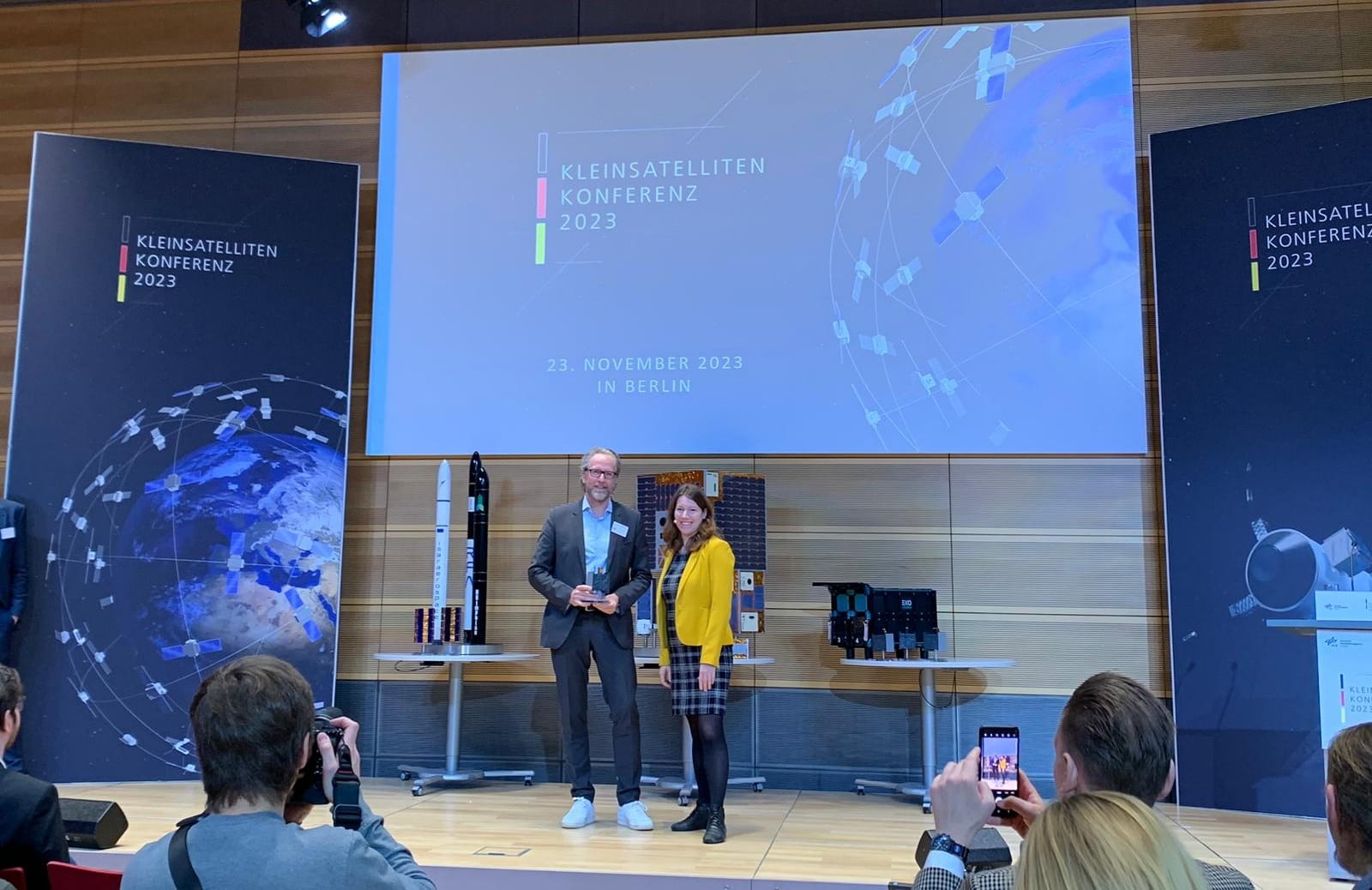
ESA´s “Zero Debris Charter” finalized – HPS among the first to sign
November 2023
ESA´s “Zero Debris Charter” finalized – HPS among the first to sign
Initiated by ESA´s office for “Strategy and Transformation” a considerable group of European space companies, including HPS, got together in order to jointly draft and now implement this continent´s set of rules for sustainable use of space. HPS is one of the first companies to sign the document on November 7th, 2023. Though legally non-binding, the “Zero Debris Charter” aims at putting an end to the inconsiderate and irresponsible pollution of space with tech-junk. In detail, the Charter clearly names the following targets:
- The probability of space debris generation through collisions and break-ups should remain below 1 in 1,000 per object during the entire orbital lifetime. A suitable aggregate probability threshold for constellations of satellites in the low Earth orbit region should be identified.
- Timely clearance of low Earth orbit and geostationary Earth orbit regions should be achieved with a probability of success of at least 99% after end of mission, including through external means when necessary.
- The casualty risk from re-entering objects should remain significantly lower than 1 in 10,000, striving towards zero casualty. A suitable aggregate risk threshold for constellations of satellites in the low Earth orbit region should be identified.
- Routine and transparent information sharing should be facilitated and active participation in strengthening global space traffic coordination mechanisms should be encouraged.
- Access to timely and accurate data on space objects down to a size of 5 cm or smaller in low Earth orbit and 20 cm or smaller in geostationary Earth orbit should be improved to enhance decision making capabilities for collision avoidance.*
Ernst K. Pfeiffer, CEO of HPS at the signature ceremony: “In our days now space is rapidly developing into the most important resource for the implementation of new technologies shaping our future on Earth. All efforts to preserve space from the beginning are therefore nothing less than efforts to preserve the fundamental conditions of life and its prosperity for humankind´s generations to come.”
*For more see:
*https://esoc.esa.int/zero-debris-community-update
*https://www.esa.int/Space_Safety/Clean_Space/World-first_Zero_Debris_Charter_goes_live
*https://www.esa.int/Space_Safety/Clean_Space/ESA_s_Zero_Debris_approach
*https://www.esa.int/Space_Safety/Clean_Space/The_Zero_Debris_Charter

